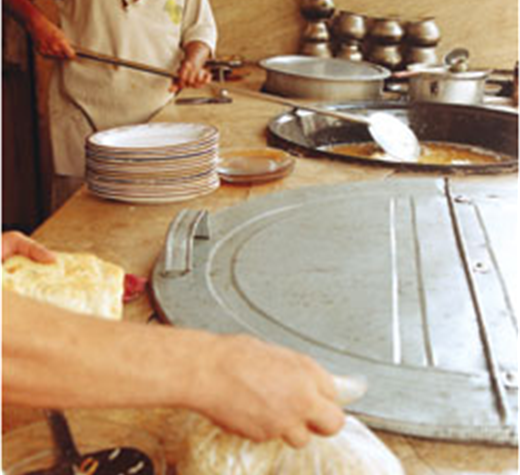Karachi: Sohrab Goth/ Al-Asif Square
This is a collection of articles archived for the excellence of their content. Readers will be able to edit existing articles and post new articles directly |
Karachi:Sohrab Goth/ Al-Asif Square
Of Kabuli pulao and namkeen ghosht
By Osman Samiuddin
“Heard about the man falling off a 50-storey building?” philosophises Hubert to his delinquent mate Vinz in the 1995 French classic La Haine (Hate). “As he falls, he repeats to himself, ‘So far so good, so far so good, so far so good.’ Thing is, how you fall doesn’t matter. It’s where you land.”
A 24-hour slice of life from the notorious Paris banlieues (ghettos), the film casually captures police brutality, ethic tension, disenchanted youth and a spiralling descent into hate, in a Paris sans fashion, sans glamour, the Eiffel Tower or the Champs Elysees. Souls in Karachi’s Al-Asif Square at Sohrab Goth may not get Hubert’s language but the message, they might.
Little, possibly none, of what we read about Al-Asif Square is enticing. The ills that plague it speak loudly of modern Karachi: poverty, riots, violence, human trafficking, drugs, arms smuggling and cramped apartments.
No longer is there the robust Hindu presence, which quietly moved out once Afghans and Pakhtoons moved into the newly-constructed flats during the early 1980s and well, from what we read, they’re rarely up to any good; or are they? Many of them are smugglers, others drive buses badly, or are refugees, terrorists or Taliban-sympathisers. Why they are never recognised for the damn fine cooks they obviously are is one of the tragic fallouts of 9/11. Especially the folks behind the Al-Madinah joint.
Be warned, for no roads lead to the restaurant, merely paths of indeterminate surface. Getting there is a tussle, but drive to the edge of Karachi (if you get to Hyderabad, you’ve gone too far). Turn left into the square where it seems least inappropriate. Fret not, you aren’t in Peshawar’s Kaarkhana Bazaar despite the identical, closeted, dimly-lit cut n’ thrustability; a sniff of a bargain here, a hint of a rip-off there, a wink here, a nod there. It is, from Karachi, a world apart. There is little you won’t find in them kiosks, even my companion assures me, fresh cream which has given the rest of Karachi a miss currently.
Suddenly, from amid this motley mass, after a spate of impossible turns and winding lanes, emerges the courtyard where stands Al-Madinah, neighbouring naturally Al-Makkah hotel. Our waiter confides conspiratorially that Al-Makkah used to be called Sarapol, thereby grandly exposing its unholy roots. Holiest or not, its fare can’t be as good as its twinned restaurant, even if the kitchens are close enough for recipes to be plundered freely.
Haaji Rasool, whose Al-Madinah it is, has fed people here for 22 years. His brother ran it before moving to Saudi Arabia. He is from Bajaur, and so gentle, warm and ever-smiling that he should be a poster-boy to shatter myths about his people the world over. Had any neo-con dined here first, the world may have avoided the strife it finds itself in.
Al-Madinah is unadorned; Makkah is framed on the nicotine wall, in faith, not competition. Madinah is next to it, of course. Table and chairs provide an apologetic concession to the western decorum, and the carpeted, raised platform (behind purdah for families) is more comfortable and inconspicuous. The food is as Spartan as the décor, though no less magnificent for it.
Head and heart say no to Kabuli pulao, bathed as it is in animal fat, but it is a battle they are destined to lose to the taste bud. Simplicity is paramount; raisins, carrots idling with the rice, manfully covering the delights of mutton at the bottom. Find it, enjoy it but pace yourself for servings are deceptive.
Some racism is inherent for the meat is only red, even the tikka; but safely I can say that a better tikka you won’t eat. The key again is scarcity of ingredient, for there appears nothing to it but some magic mingling of meat and salt. Perhaps the secret is in the barbeque, or the chunks of fat nestled in between.
One plate is enough for three, especially if you complement it with namkeen ghosht. Wallowing in its own stock –– doubling as soup if poshness overtakes –– it is the least of the dishes, though delightful still, and to be picked at with a naan. And a better naan, for taste, temperature, texture or design, is difficult to find. Three dishes are enough for three and if you want to take away and spread the word, you still have enough change from Rs500 to buy three tapes of Persian music from the shop a lane down.
Finally, then, some good news about Al-Asif Square, whose bark appears worse than its bite. Turns out, how you fall really doesn’t matter, as long as you land in Al-Madinah.

